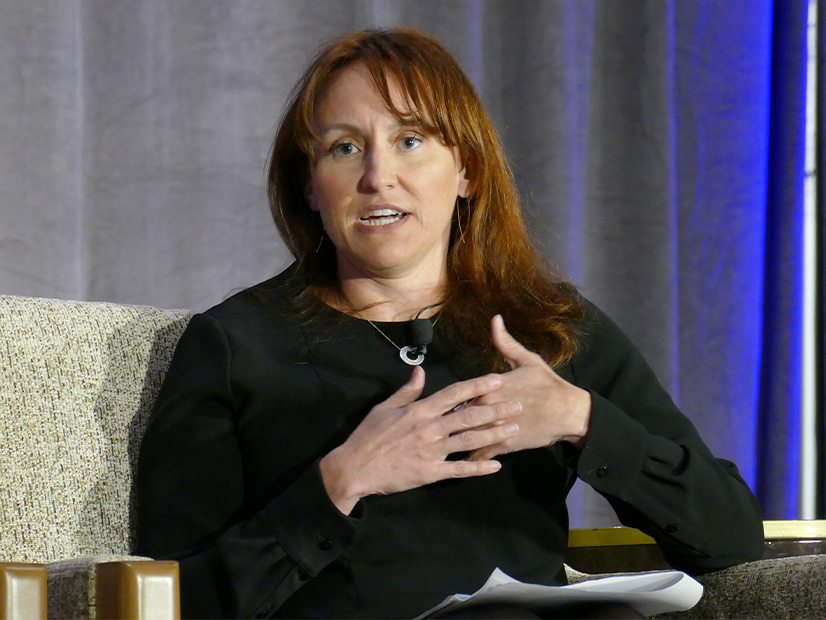WASHINGTON — More than 1,000 people traveled to D.C. for the National Association of Regulatory Utility Commissioners’ Winter Policy Summit last week, a hybrid affair that also offered video feeds for many sessions. Much of the talk was about the $62.5 billion in funding the Department of Energy received under the Infrastructure Investment and Jobs Act (IIJA).
Granholm: DOE Learning to Use ‘New Muscles’
The infrastructure bill is not only the biggest influx of funding in DOE’s history. It also marks a change in the department’s role regarding new technology, Energy Secretary Jennifer Granholm told the conference Feb. 15.
 Energy Secretary Jennifer Granholm | NARUC
Energy Secretary Jennifer Granholm | NARUC“It expands our department’s mandate to get clean energy technologies out into the world through demonstration and deployment. It’s a new muscle for us,” Granholm said, speaking to NARUC members via a video feed. “We’ve been really historically a research and development [agency] … with our National Labs. And now we are exercising a whole new muscle.”
Although the bill’s $615 million in funding for electric vehicle charging infrastructure is being awarded under Department of Transportation formula allocations, most of DOE’s funding from the IIJA will be awarded competitively, Granholm said. (See States to Get $615 Million for EV Charging from IIJA Funds.)
“Many of these are new programs,” she said. “So, we’re asking folks to send us their best, most innovative ideas. We want to solicit proposals that invest in rural and underserved communities. We want to bring in smaller utilities. We want to have maximum impact for climate and job creation and justice. So we are very excited about what this law means for DOE, and obviously everyone in [the NARUC conference] room, and for the country and the planners. We just can’t wait to work with you to get this done.”
DOE’s Energy Earthshots
Earlier Tuesday, the conference received a briefing on DOE’s three “Energy Earthshots,” initiatives to accelerate new technologies in order to meet President Biden’s targets of complete grid decarbonization by 2035 and net-zero emissions by 2050.
Each initiative has its own cost-reduction target to achieve wide-scale deployment. The department received IIJA funding dedicated to research and development of each of the technologies: $9.5 billion for clean hydrogen; more than $10 billion for carbon capture and removal; and more than $7 billion in the supply chain for batteries.
Three DOE officials gave NARUC attendees an overview of each Earthshot, laying out just how ambitious the targets are and how necessary they will be in the future.
The goal of the Hydrogen Shot is to cut the cost of “green” hydrogen — produced with renewable power — to $1/kg by 2030. Because it can be used in so many different ways and in so many different sectors, producing it at scale will require unprecedented collaboration, said Kelly Speakes-Backman, of the Office of Energy Efficiency and Renewable Energy.
“Hydrogen is going to involve a greater integration of our Renewable, Fossil and Nuclear offices,” Kelly Speakes-Backman said. “It’s going to take an integrated approach across all sectors to realize the full benefits of hydrogen.”
Michael Pesin, of the Office of Electricity, discussed the Long Duration Storage Shot, which aims to cut the cost of utility-scale storage that can last more than 10 hours by 90% by 2035.
He presented a graph showing the staggering amount of short-duration (up to four hours) storage that would be needed to achieve the president’s 2035 target: up to 800 GW under a “high” scenario to be detailed in a future DOE report.
But the longer resources can last, the less capacity is needed. And by 2050, the U.S. will need storage that can last more than 100 hours and can be cycled seasonally or even weekly, Pesin said, because of equally staggering amount of renewables that are expected to be on the grid by then.
“This is a very aggressive goal; we realize that,” he said. “But we’re going to [use] all the resources of the department and work with industry and all of you to make sure we can achieve this.”
Finally, and perhaps most importantly, is the Carbon Negative Shot. Announced in November, it aims to reduce the cost of carbon dioxide removal (CDR) technologies to less than $100/net metric ton of CO2e.
The initiative is not about point-source emissions capture, said Emily Grubert, of the Office of Fossil Energy and Carbon Management. Nor is it about carbon avoidance and mitigation practices, though all are important to achieving net-zero emissions. It’s about directly removing carbon that is already in the atmosphere and oceans.
The goal is to enable gigaton-scale carbon removal. “To put this into perspective, 1 GT of CO2 is equivalent to the annual emissions from the U.S. light-duty vehicle fleet, according to a DOE factsheet on the initiative. “This is equal to approximately 250 million vehicles driven in one year.”
“Net zero can not happen without gigaton-scale CDR, based on a lot of the modeling we’ve globally and domestically,” Grubert said.
The department expects to establish at least three more Earthshots in the future. Grubert noted that the Carbon Negative Shot is the “youngest” of the current three, “but hopefully not for long.”
ACP Chief Cool to FERC ‘Backstop’ Authority
Speaking after Granholm, Heather Zichal, CEO of the American Clean Power Association, noted that most of the infrastructure funding will be spent over five to 10 years, unlike the spending in the pandemic recovery legislation, where the priority was to “get the money out the door as quickly as possible.”
“So we have a little bit more time to get the projects right, and get the processes right,” she said.
Zichal said she sees the infrastructure’s transmission funding as helping to accomplish three goals: preventing outages from natural disasters; relieving congestion that increases consumers’ costs and limits the connection of new renewable generation and deploying new technology, including offshore wind, microgrids and hybrid projects incorporating storage.
Like FERC Chairman Richard Glick, Zichal sought to lower expectations for the “backstop” authority the bill gave the commission to site transmission lines over state objections or delays. Glick told National Association of State Energy Officials conference attendees Feb. 9 that he doesn’t expect many utilities to ask FERC to overrule their state regulators. (See Glick Aiming for Final Transmission Rule by End of Year.)
North Dakota Public Service Commissioner Julie Fedorchak asked Zichal whether FERC’s exercise of that authority would result in better outcomes.
“That’s quite the question,” Zichal joked in response. “I might not have any friends [among state regulators] after answering it.
“When you have new authority, using it for the first time is scary and often a lot more difficult than you probably anticipated,” Zichal said. “Most major infrastructure projects are successful when they have strong buy-in at the state, local and regional level. And so I think that’s going to be … the key to success for any of these major transmission projects. …
“Without the local and regional support, you’re just not going to see those projects come to fruition,” she continued. “I think there are major questions around whether and how, the new authority in the bipartisan infrastructure bill would even be utilized.”
“I agree with you,” responded Fedorchak. “I think the states will get it done. Right, guys? We can do this.”


